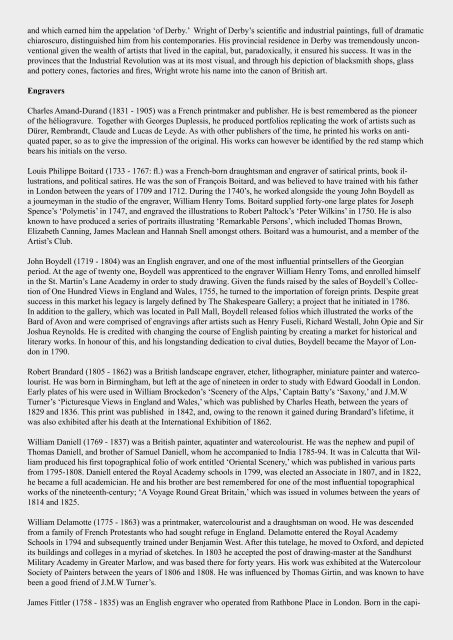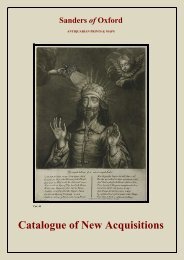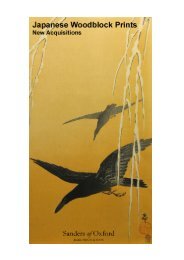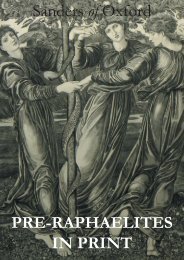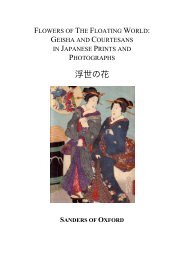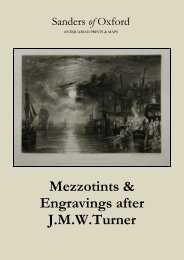catalogue text.indd - Sanders of Oxford
catalogue text.indd - Sanders of Oxford
catalogue text.indd - Sanders of Oxford
Create successful ePaper yourself
Turn your PDF publications into a flip-book with our unique Google optimized e-Paper software.
and which earned him the appelation ‘<strong>of</strong> Derby.’ Wright <strong>of</strong> Derby’s scientific and industrial paintings, full <strong>of</strong> dramatic<br />
chiaroscuro, distinguished him from his contemporaries. His provincial residence in Derby was tremendously unconventional<br />
given the wealth <strong>of</strong> artists that lived in the capital, but, paradoxically, it ensured his success. It was in the<br />
provinces that the Industrial Revolution was at its most visual, and through his depiction <strong>of</strong> blacksmith shops, glass<br />
and pottery cones, factories and fires, Wright wrote his name into the canon <strong>of</strong> British art.<br />
Engravers<br />
Charles Amand-Durand (1831 - 1905) was a French printmaker and publisher. He is best remembered as the pioneer<br />
<strong>of</strong> the héliogravure. Together with Georges Duplessis, he produced portfolios replicating the work <strong>of</strong> artists such as<br />
Dürer, Rembrandt, Claude and Lucas de Leyde. As with other publishers <strong>of</strong> the time, he printed his works on antiquated<br />
paper, so as to give the impression <strong>of</strong> the original. His works can however be identified by the red stamp which<br />
bears his initials on the verso.<br />
Louis Philippe Boitard (1733 - 1767: fl.) was a French-born draughtsman and engraver <strong>of</strong> satirical prints, book illustrations,<br />
and political satires. He was the son <strong>of</strong> François Boitard, and was believed to have trained with his father<br />
in London between the years <strong>of</strong> 1709 and 1712. During the 1740’s, he worked alongside the young John Boydell as<br />
a journeyman in the studio <strong>of</strong> the engraver, William Henry Toms. Boitard supplied forty-one large plates for Joseph<br />
Spence’s ‘Polymetis’ in 1747, and engraved the illustrations to Robert Paltock’s ‘Peter Wilkins’ in 1750. He is also<br />
known to have produced a series <strong>of</strong> portraits illustrating ‘Remarkable Persons’, which included Thomas Brown,<br />
Elizabeth Canning, James Maclean and Hannah Snell amongst others. Boitard was a humourist, and a member <strong>of</strong> the<br />
Artist’s Club.<br />
John Boydell (1719 - 1804) was an English engraver, and one <strong>of</strong> the most influential printsellers <strong>of</strong> the Georgian<br />
period. At the age <strong>of</strong> twenty one, Boydell was apprenticed to the engraver William Henry Toms, and enrolled himself<br />
in the St. Martin’s Lane Academy in order to study drawing. Given the funds raised by the sales <strong>of</strong> Boydell’s Collection<br />
<strong>of</strong> One Hundred Views in England and Wales, 1755, he turned to the importation <strong>of</strong> foreign prints. Despite great<br />
success in this market his legacy is largely defined by The Shakespeare Gallery; a project that he initiated in 1786.<br />
In addition to the gallery, which was located in Pall Mall, Boydell released folios which illustrated the works <strong>of</strong> the<br />
Bard <strong>of</strong> Avon and were comprised <strong>of</strong> engravings after artists such as Henry Fuseli, Richard Westall, John Opie and Sir<br />
Joshua Reynolds. He is credited with changing the course <strong>of</strong> English painting by creating a market for historical and<br />
literary works. In honour <strong>of</strong> this, and his longstanding dedication to cival duties, Boydell became the Mayor <strong>of</strong> London<br />
in 1790.<br />
Robert Brandard (1805 - 1862) was a British landscape engraver, etcher, lithographer, miniature painter and watercolourist.<br />
He was born in Birmingham, but left at the age <strong>of</strong> nineteen in order to study with Edward Goodall in London.<br />
Early plates <strong>of</strong> his were used in William Brockedon’s ‘Scenery <strong>of</strong> the Alps,’ Captain Batty’s ‘Saxony,’ and J.M.W<br />
Turner’s ‘Picturesque Views in England and Wales,’ which was published by Charles Heath, between the years <strong>of</strong><br />
1829 and 1836. This print was published in 1842, and, owing to the renown it gained during Brandard’s lifetime, it<br />
was also exhibited after his death at the International Exhibition <strong>of</strong> 1862.<br />
William Daniell (1769 - 1837) was a British painter, aquatinter and watercolourist. He was the nephew and pupil <strong>of</strong><br />
Thomas Daniell, and brother <strong>of</strong> Samuel Daniell, whom he accompanied to India 1785-94. It was in Calcutta that William<br />
produced his first topographical folio <strong>of</strong> work entitled ‘Oriental Scenery,’ which was published in various parts<br />
from 1795-1808. Daniell entered the Royal Academy schools in 1799, was elected an Associate in 1807, and in 1822,<br />
he became a full academician. He and his brother are best remembered for one <strong>of</strong> the most influential topographical<br />
works <strong>of</strong> the nineteenth-century; ‘A Voyage Round Great Britain,’ which was issued in volumes between the years <strong>of</strong><br />
1814 and 1825.<br />
William Delamotte (1775 - 1863) was a printmaker, watercolourist and a draughtsman on wood. He was descended<br />
from a family <strong>of</strong> French Protestants who had sought refuge in England. Delamotte entered the Royal Academy<br />
Schools in 1794 and subsequently trained under Benjamin West. After this tutelage, he moved to <strong>Oxford</strong>, and depicted<br />
its buildings and colleges in a myriad <strong>of</strong> sketches. In 1803 he accepted the post <strong>of</strong> drawing-master at the Sandhurst<br />
Military Academy in Greater Marlow, and was based there for forty years. His work was exhibited at the Watercolour<br />
Society <strong>of</strong> Painters between the years <strong>of</strong> 1806 and 1808. He was influenced by Thomas Girtin, and was known to have<br />
been a good friend <strong>of</strong> J.M.W Turner’s.<br />
James Fittler (1758 - 1835) was an English engraver who operated from Rathbone Place in London. Born in the capi-


